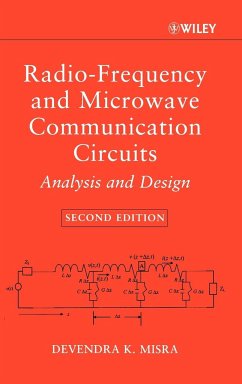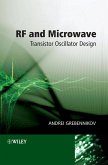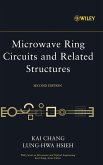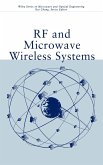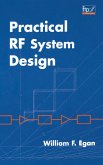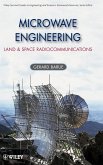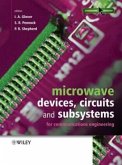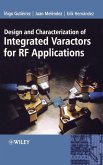- Gebundenes Buch
- Merkliste
- Auf die Merkliste
- Bewerten Bewerten
- Teilen
- Produkt teilen
- Produkterinnerung
- Produkterinnerung
The products that drive the wireless communication industry, such as cell phones and pagers, employ circuits that operate at radio and microwave frequencies. Following on from a highly successful first edition, the second edition provides readers with a detailed introduction to RF and microwave circuits. Throughout, examples from real-world devices and engineering problems are used to great effect to illustrate circuit concepts. _ Takes a top-down approach, describing circuits in the overall context of communication systems. _ Presents expanded coverage of waveguides and FT mixers. _ Discusses…mehr
Andere Kunden interessierten sich auch für
![RF and Microwave Transistor Oscillator Design RF and Microwave Transistor Oscillator Design]() Andrei GrebennikovRF and Microwave Transistor Oscillator Design203,99 €
Andrei GrebennikovRF and Microwave Transistor Oscillator Design203,99 €![Microwave Ring Circuits and Related Structures Microwave Ring Circuits and Related Structures]() Kai ChangMicrowave Ring Circuits and Related Structures306,99 €
Kai ChangMicrowave Ring Circuits and Related Structures306,99 €![RF and Microwave Wireless Systems RF and Microwave Wireless Systems]() Kai ChangRF and Microwave Wireless Systems199,99 €
Kai ChangRF and Microwave Wireless Systems199,99 €![Practical RF System Design Practical RF System Design]() William F. EganPractical RF System Design188,99 €
William F. EganPractical RF System Design188,99 €![Microwave Engineering Microwave Engineering]() Gérard BaruéMicrowave Engineering201,99 €
Gérard BaruéMicrowave Engineering201,99 €![Microwave Devices, Circuits and Subsystems for Communications Engineering Microwave Devices, Circuits and Subsystems for Communications Engineering]() Microwave Devices, Circuits and Subsystems for Communications Engineering281,99 €
Microwave Devices, Circuits and Subsystems for Communications Engineering281,99 €![Design and Characterization of Integrated Varactors for RF Applications Design and Characterization of Integrated Varactors for RF Applications]() Inigo GutierrezDesign and Characterization of Integrated Varactors for RF Applications148,99 €
Inigo GutierrezDesign and Characterization of Integrated Varactors for RF Applications148,99 €-
-
-
The products that drive the wireless communication industry, such as cell phones and pagers, employ circuits that operate at radio and microwave frequencies. Following on from a highly successful first edition, the second edition provides readers with a detailed introduction to RF and microwave circuits. Throughout, examples from real-world devices and engineering problems are used to great effect to illustrate circuit concepts.
_ Takes a top-down approach, describing circuits in the overall context of communication systems.
_ Presents expanded coverage of waveguides and FT mixers.
_ Discusses new areas such as oscillators design and digital communication.
_ Takes a top-down approach, describing circuits in the overall context of communication systems.
_ Presents expanded coverage of waveguides and FT mixers.
_ Discusses new areas such as oscillators design and digital communication.
Produktdetails
- Produktdetails
- A Wiley-Interscience Publication
- Verlag: Wiley & Sons
- 2. Aufl.
- Seitenzahl: 632
- Erscheinungstermin: 30. Juli 2004
- Englisch
- Abmessung: 240mm x 161mm x 38mm
- Gewicht: 996g
- ISBN-13: 9780471478737
- ISBN-10: 0471478733
- Artikelnr.: 12965276
- A Wiley-Interscience Publication
- Verlag: Wiley & Sons
- 2. Aufl.
- Seitenzahl: 632
- Erscheinungstermin: 30. Juli 2004
- Englisch
- Abmessung: 240mm x 161mm x 38mm
- Gewicht: 996g
- ISBN-13: 9780471478737
- ISBN-10: 0471478733
- Artikelnr.: 12965276
DEVENDRA K. MISRA, PhD, is Professor and Chair of Electrical Engineering in the Department of Electrical Engineering and Computer Science at the University of Wisconsin-Milwaukee. A senior member of the IEEE and associate editor of IEEE Transactions on Instrumentation and Measurement and the Journal of Subsurface Sensing, he received his PhD in Electrical Engineering from Michigan State University.
1 Introduction. 1.1 Microwave Transmission Lines. 1.2 Transmitter and
Receiver Architectures. 2 Communication Systems. 2.1 Terrestrial
Communication. 2.2 Satellite Communication. 2.3 Radio-Frequency Wireless
Services. 2.4 Antenna Systems. 2.5 Noise and Distortion. Suggested Reading.
Problems. 3 Transmission Lines. 3.1 Distributed Circuit Analysis of
Transmission Lines. 3.2 Sending-End Impedance. 3.3 Standing Wave and
Standing Wave Ratio. 3.4 Smith Chart. Suggested Reading. Problems. 4
Electromagnetic Fields and Waves. 4.1 Fundamental Laws of Electromagnetic
Fields. 4.2 The Wave Equation and Uniform Plane Wave Solutions. 4.3
Boundary Conditions. 4.4 Uniform Plane Wave Incident Normally on an
Interface. 4.5 Modified Maxwell's Equations and Potential Functions. 4.6
Construction of Solutions. 4.7 Metallic Parallel-Plate Waveguide. 4.8
Metallic Rectangular Waveguide. 4.9 Metallic Circular Waveguide. Suggested
Reading. Problems. 5 Resonant Circuits. 5.1 Series Resonant Circuits. 5.2
Parallel Resonant Circuits. 5.3 Transformer-Coupled Circuits. 5.4
Transmission Line Resonant Circuits. 5.5 Microwave Resonators. Suggested
Reading. Problems. 6 Impedance-Matching Networks. 6.1 Single Reactive
Element or Stub Matching Networks. 6.2 Double-Stub Matching Networks. 6.3
Matching Networks Using Lumped Elements. Suggested Reading. Problems. 7
Impedance Transformers. 7.1 Single-Section Quarter-Wave Transformers. 7.2
Multisection Quarter-Wave Transformers. 7.3 Transformer with Uniformly
Distributed Section Reflection Coefficients. 7.4 Binomial Transformers. 7.5
Chebyshev Transformers. 7.6 Exact Formulation and Design of Multisection
Impedance Transformers. 7.7 Tapered Transmission Lines. 7.8 Synthesis of
Transmission Line Tapers. 7.9 Bode-Fano Constraints for Lossless Matching
Networks. Suggested Reading. Problems. 8 Two-Port Networks. 8.1 Impedance
Parameters. 8.2 Admittance Parameters. 8.3 Hybrid Parameters. 8.4
Transmission Parameters. 8.5 Conversion of Impedance, Admittance, Chain,
and Hybrid Parameters. 8.6 Scattering Parameters. 8.7 Conversion From
Impedance, Admittance, Chain, and Hybrid Parameters to Scattering
Parameters, or Vice Versa. 8.8 Chain Scattering Parameters. Suggested
Reading. Problems. 9 Filter Design. 9.1 Image Parameter Method. 9.2
Insertion-Loss Method. 9.3 Microwave Filters. Suggested Reading. Problems.
10 Signal-Flow Graphs and Their Applications. 10.1 Definitions and
Manipulation of Signal-Flow Graphs. 10.2 Signal-Flow Graph Representation
of a Voltage Source. 10.3 Signal-Flow Graph Representation of a Passive
Single-Port Device. 10.4 Power Gain Equations. Suggested Reading. Problems.
11 Transistor Amplifier Design. 11.1 Stability Considerations. 11.2
Amplifier Design for Maximum Gain. 11.3 Constant-Gain Circles. 11.4
Constant Noise Figure Circles. 11.5 Broadband Amplifiers. 11.6 Small-Signal
Equivalent-Circuit Models of Transistors. 11.7 DC Bias Circuits for
Transistors. Suggested Reading. Problems. 12 Oscillator Design. 12.1
Feedback and Basic Concepts. 12.2 Crystal Oscillators. 12.3 Electronic
Tuning of Oscillators. 12.4 Phase-Locked Loop. 12.5 Frequency Synthesizers.
12.6 One-Port Negative Resistance Oscillators. 12.7 Microwave Transistor
Oscillators. Suggested Reading. Problems. 13 Detectors and Mixers. 13.1
Amplitude Modulation. 13.2 Frequency Modulation. 13.3 Switching-Type
Mixers. 13.4 Conversion Loss. 13.5 Intermodulation Distortion in Diode-Ring
Mixers. 13.6 FET Mixers. Suggested Reading. Problems. Appendix 1: Decibels
and Neper. Appendix 2" Characteristics of Selected Transmission Lines.
Appendix 3: Specifications of Selected Coaxial Lines and Waveguides.
Appendix 4: Some Mathematical Formulas. Appendix 5: Vector Identities.
Appendix 6: Some Useful Network Transformations. Appendix 7: Properties of
Some Materials. Appendix 8: Common Abbreviations. Appendix 9: Physical
Constants. Index.
Receiver Architectures. 2 Communication Systems. 2.1 Terrestrial
Communication. 2.2 Satellite Communication. 2.3 Radio-Frequency Wireless
Services. 2.4 Antenna Systems. 2.5 Noise and Distortion. Suggested Reading.
Problems. 3 Transmission Lines. 3.1 Distributed Circuit Analysis of
Transmission Lines. 3.2 Sending-End Impedance. 3.3 Standing Wave and
Standing Wave Ratio. 3.4 Smith Chart. Suggested Reading. Problems. 4
Electromagnetic Fields and Waves. 4.1 Fundamental Laws of Electromagnetic
Fields. 4.2 The Wave Equation and Uniform Plane Wave Solutions. 4.3
Boundary Conditions. 4.4 Uniform Plane Wave Incident Normally on an
Interface. 4.5 Modified Maxwell's Equations and Potential Functions. 4.6
Construction of Solutions. 4.7 Metallic Parallel-Plate Waveguide. 4.8
Metallic Rectangular Waveguide. 4.9 Metallic Circular Waveguide. Suggested
Reading. Problems. 5 Resonant Circuits. 5.1 Series Resonant Circuits. 5.2
Parallel Resonant Circuits. 5.3 Transformer-Coupled Circuits. 5.4
Transmission Line Resonant Circuits. 5.5 Microwave Resonators. Suggested
Reading. Problems. 6 Impedance-Matching Networks. 6.1 Single Reactive
Element or Stub Matching Networks. 6.2 Double-Stub Matching Networks. 6.3
Matching Networks Using Lumped Elements. Suggested Reading. Problems. 7
Impedance Transformers. 7.1 Single-Section Quarter-Wave Transformers. 7.2
Multisection Quarter-Wave Transformers. 7.3 Transformer with Uniformly
Distributed Section Reflection Coefficients. 7.4 Binomial Transformers. 7.5
Chebyshev Transformers. 7.6 Exact Formulation and Design of Multisection
Impedance Transformers. 7.7 Tapered Transmission Lines. 7.8 Synthesis of
Transmission Line Tapers. 7.9 Bode-Fano Constraints for Lossless Matching
Networks. Suggested Reading. Problems. 8 Two-Port Networks. 8.1 Impedance
Parameters. 8.2 Admittance Parameters. 8.3 Hybrid Parameters. 8.4
Transmission Parameters. 8.5 Conversion of Impedance, Admittance, Chain,
and Hybrid Parameters. 8.6 Scattering Parameters. 8.7 Conversion From
Impedance, Admittance, Chain, and Hybrid Parameters to Scattering
Parameters, or Vice Versa. 8.8 Chain Scattering Parameters. Suggested
Reading. Problems. 9 Filter Design. 9.1 Image Parameter Method. 9.2
Insertion-Loss Method. 9.3 Microwave Filters. Suggested Reading. Problems.
10 Signal-Flow Graphs and Their Applications. 10.1 Definitions and
Manipulation of Signal-Flow Graphs. 10.2 Signal-Flow Graph Representation
of a Voltage Source. 10.3 Signal-Flow Graph Representation of a Passive
Single-Port Device. 10.4 Power Gain Equations. Suggested Reading. Problems.
11 Transistor Amplifier Design. 11.1 Stability Considerations. 11.2
Amplifier Design for Maximum Gain. 11.3 Constant-Gain Circles. 11.4
Constant Noise Figure Circles. 11.5 Broadband Amplifiers. 11.6 Small-Signal
Equivalent-Circuit Models of Transistors. 11.7 DC Bias Circuits for
Transistors. Suggested Reading. Problems. 12 Oscillator Design. 12.1
Feedback and Basic Concepts. 12.2 Crystal Oscillators. 12.3 Electronic
Tuning of Oscillators. 12.4 Phase-Locked Loop. 12.5 Frequency Synthesizers.
12.6 One-Port Negative Resistance Oscillators. 12.7 Microwave Transistor
Oscillators. Suggested Reading. Problems. 13 Detectors and Mixers. 13.1
Amplitude Modulation. 13.2 Frequency Modulation. 13.3 Switching-Type
Mixers. 13.4 Conversion Loss. 13.5 Intermodulation Distortion in Diode-Ring
Mixers. 13.6 FET Mixers. Suggested Reading. Problems. Appendix 1: Decibels
and Neper. Appendix 2" Characteristics of Selected Transmission Lines.
Appendix 3: Specifications of Selected Coaxial Lines and Waveguides.
Appendix 4: Some Mathematical Formulas. Appendix 5: Vector Identities.
Appendix 6: Some Useful Network Transformations. Appendix 7: Properties of
Some Materials. Appendix 8: Common Abbreviations. Appendix 9: Physical
Constants. Index.
1 Introduction. 1.1 Microwave Transmission Lines. 1.2 Transmitter and
Receiver Architectures. 2 Communication Systems. 2.1 Terrestrial
Communication. 2.2 Satellite Communication. 2.3 Radio-Frequency Wireless
Services. 2.4 Antenna Systems. 2.5 Noise and Distortion. Suggested Reading.
Problems. 3 Transmission Lines. 3.1 Distributed Circuit Analysis of
Transmission Lines. 3.2 Sending-End Impedance. 3.3 Standing Wave and
Standing Wave Ratio. 3.4 Smith Chart. Suggested Reading. Problems. 4
Electromagnetic Fields and Waves. 4.1 Fundamental Laws of Electromagnetic
Fields. 4.2 The Wave Equation and Uniform Plane Wave Solutions. 4.3
Boundary Conditions. 4.4 Uniform Plane Wave Incident Normally on an
Interface. 4.5 Modified Maxwell's Equations and Potential Functions. 4.6
Construction of Solutions. 4.7 Metallic Parallel-Plate Waveguide. 4.8
Metallic Rectangular Waveguide. 4.9 Metallic Circular Waveguide. Suggested
Reading. Problems. 5 Resonant Circuits. 5.1 Series Resonant Circuits. 5.2
Parallel Resonant Circuits. 5.3 Transformer-Coupled Circuits. 5.4
Transmission Line Resonant Circuits. 5.5 Microwave Resonators. Suggested
Reading. Problems. 6 Impedance-Matching Networks. 6.1 Single Reactive
Element or Stub Matching Networks. 6.2 Double-Stub Matching Networks. 6.3
Matching Networks Using Lumped Elements. Suggested Reading. Problems. 7
Impedance Transformers. 7.1 Single-Section Quarter-Wave Transformers. 7.2
Multisection Quarter-Wave Transformers. 7.3 Transformer with Uniformly
Distributed Section Reflection Coefficients. 7.4 Binomial Transformers. 7.5
Chebyshev Transformers. 7.6 Exact Formulation and Design of Multisection
Impedance Transformers. 7.7 Tapered Transmission Lines. 7.8 Synthesis of
Transmission Line Tapers. 7.9 Bode-Fano Constraints for Lossless Matching
Networks. Suggested Reading. Problems. 8 Two-Port Networks. 8.1 Impedance
Parameters. 8.2 Admittance Parameters. 8.3 Hybrid Parameters. 8.4
Transmission Parameters. 8.5 Conversion of Impedance, Admittance, Chain,
and Hybrid Parameters. 8.6 Scattering Parameters. 8.7 Conversion From
Impedance, Admittance, Chain, and Hybrid Parameters to Scattering
Parameters, or Vice Versa. 8.8 Chain Scattering Parameters. Suggested
Reading. Problems. 9 Filter Design. 9.1 Image Parameter Method. 9.2
Insertion-Loss Method. 9.3 Microwave Filters. Suggested Reading. Problems.
10 Signal-Flow Graphs and Their Applications. 10.1 Definitions and
Manipulation of Signal-Flow Graphs. 10.2 Signal-Flow Graph Representation
of a Voltage Source. 10.3 Signal-Flow Graph Representation of a Passive
Single-Port Device. 10.4 Power Gain Equations. Suggested Reading. Problems.
11 Transistor Amplifier Design. 11.1 Stability Considerations. 11.2
Amplifier Design for Maximum Gain. 11.3 Constant-Gain Circles. 11.4
Constant Noise Figure Circles. 11.5 Broadband Amplifiers. 11.6 Small-Signal
Equivalent-Circuit Models of Transistors. 11.7 DC Bias Circuits for
Transistors. Suggested Reading. Problems. 12 Oscillator Design. 12.1
Feedback and Basic Concepts. 12.2 Crystal Oscillators. 12.3 Electronic
Tuning of Oscillators. 12.4 Phase-Locked Loop. 12.5 Frequency Synthesizers.
12.6 One-Port Negative Resistance Oscillators. 12.7 Microwave Transistor
Oscillators. Suggested Reading. Problems. 13 Detectors and Mixers. 13.1
Amplitude Modulation. 13.2 Frequency Modulation. 13.3 Switching-Type
Mixers. 13.4 Conversion Loss. 13.5 Intermodulation Distortion in Diode-Ring
Mixers. 13.6 FET Mixers. Suggested Reading. Problems. Appendix 1: Decibels
and Neper. Appendix 2" Characteristics of Selected Transmission Lines.
Appendix 3: Specifications of Selected Coaxial Lines and Waveguides.
Appendix 4: Some Mathematical Formulas. Appendix 5: Vector Identities.
Appendix 6: Some Useful Network Transformations. Appendix 7: Properties of
Some Materials. Appendix 8: Common Abbreviations. Appendix 9: Physical
Constants. Index.
Receiver Architectures. 2 Communication Systems. 2.1 Terrestrial
Communication. 2.2 Satellite Communication. 2.3 Radio-Frequency Wireless
Services. 2.4 Antenna Systems. 2.5 Noise and Distortion. Suggested Reading.
Problems. 3 Transmission Lines. 3.1 Distributed Circuit Analysis of
Transmission Lines. 3.2 Sending-End Impedance. 3.3 Standing Wave and
Standing Wave Ratio. 3.4 Smith Chart. Suggested Reading. Problems. 4
Electromagnetic Fields and Waves. 4.1 Fundamental Laws of Electromagnetic
Fields. 4.2 The Wave Equation and Uniform Plane Wave Solutions. 4.3
Boundary Conditions. 4.4 Uniform Plane Wave Incident Normally on an
Interface. 4.5 Modified Maxwell's Equations and Potential Functions. 4.6
Construction of Solutions. 4.7 Metallic Parallel-Plate Waveguide. 4.8
Metallic Rectangular Waveguide. 4.9 Metallic Circular Waveguide. Suggested
Reading. Problems. 5 Resonant Circuits. 5.1 Series Resonant Circuits. 5.2
Parallel Resonant Circuits. 5.3 Transformer-Coupled Circuits. 5.4
Transmission Line Resonant Circuits. 5.5 Microwave Resonators. Suggested
Reading. Problems. 6 Impedance-Matching Networks. 6.1 Single Reactive
Element or Stub Matching Networks. 6.2 Double-Stub Matching Networks. 6.3
Matching Networks Using Lumped Elements. Suggested Reading. Problems. 7
Impedance Transformers. 7.1 Single-Section Quarter-Wave Transformers. 7.2
Multisection Quarter-Wave Transformers. 7.3 Transformer with Uniformly
Distributed Section Reflection Coefficients. 7.4 Binomial Transformers. 7.5
Chebyshev Transformers. 7.6 Exact Formulation and Design of Multisection
Impedance Transformers. 7.7 Tapered Transmission Lines. 7.8 Synthesis of
Transmission Line Tapers. 7.9 Bode-Fano Constraints for Lossless Matching
Networks. Suggested Reading. Problems. 8 Two-Port Networks. 8.1 Impedance
Parameters. 8.2 Admittance Parameters. 8.3 Hybrid Parameters. 8.4
Transmission Parameters. 8.5 Conversion of Impedance, Admittance, Chain,
and Hybrid Parameters. 8.6 Scattering Parameters. 8.7 Conversion From
Impedance, Admittance, Chain, and Hybrid Parameters to Scattering
Parameters, or Vice Versa. 8.8 Chain Scattering Parameters. Suggested
Reading. Problems. 9 Filter Design. 9.1 Image Parameter Method. 9.2
Insertion-Loss Method. 9.3 Microwave Filters. Suggested Reading. Problems.
10 Signal-Flow Graphs and Their Applications. 10.1 Definitions and
Manipulation of Signal-Flow Graphs. 10.2 Signal-Flow Graph Representation
of a Voltage Source. 10.3 Signal-Flow Graph Representation of a Passive
Single-Port Device. 10.4 Power Gain Equations. Suggested Reading. Problems.
11 Transistor Amplifier Design. 11.1 Stability Considerations. 11.2
Amplifier Design for Maximum Gain. 11.3 Constant-Gain Circles. 11.4
Constant Noise Figure Circles. 11.5 Broadband Amplifiers. 11.6 Small-Signal
Equivalent-Circuit Models of Transistors. 11.7 DC Bias Circuits for
Transistors. Suggested Reading. Problems. 12 Oscillator Design. 12.1
Feedback and Basic Concepts. 12.2 Crystal Oscillators. 12.3 Electronic
Tuning of Oscillators. 12.4 Phase-Locked Loop. 12.5 Frequency Synthesizers.
12.6 One-Port Negative Resistance Oscillators. 12.7 Microwave Transistor
Oscillators. Suggested Reading. Problems. 13 Detectors and Mixers. 13.1
Amplitude Modulation. 13.2 Frequency Modulation. 13.3 Switching-Type
Mixers. 13.4 Conversion Loss. 13.5 Intermodulation Distortion in Diode-Ring
Mixers. 13.6 FET Mixers. Suggested Reading. Problems. Appendix 1: Decibels
and Neper. Appendix 2" Characteristics of Selected Transmission Lines.
Appendix 3: Specifications of Selected Coaxial Lines and Waveguides.
Appendix 4: Some Mathematical Formulas. Appendix 5: Vector Identities.
Appendix 6: Some Useful Network Transformations. Appendix 7: Properties of
Some Materials. Appendix 8: Common Abbreviations. Appendix 9: Physical
Constants. Index.

